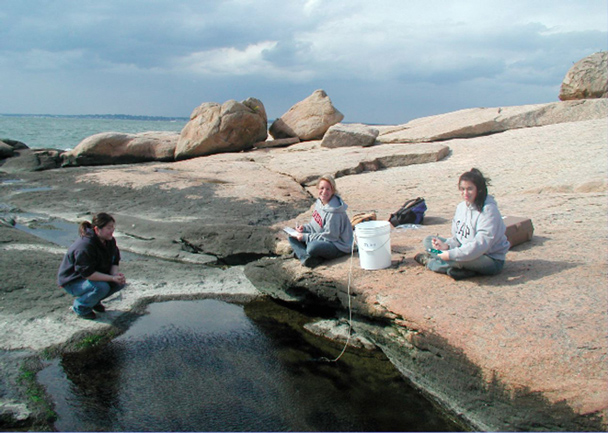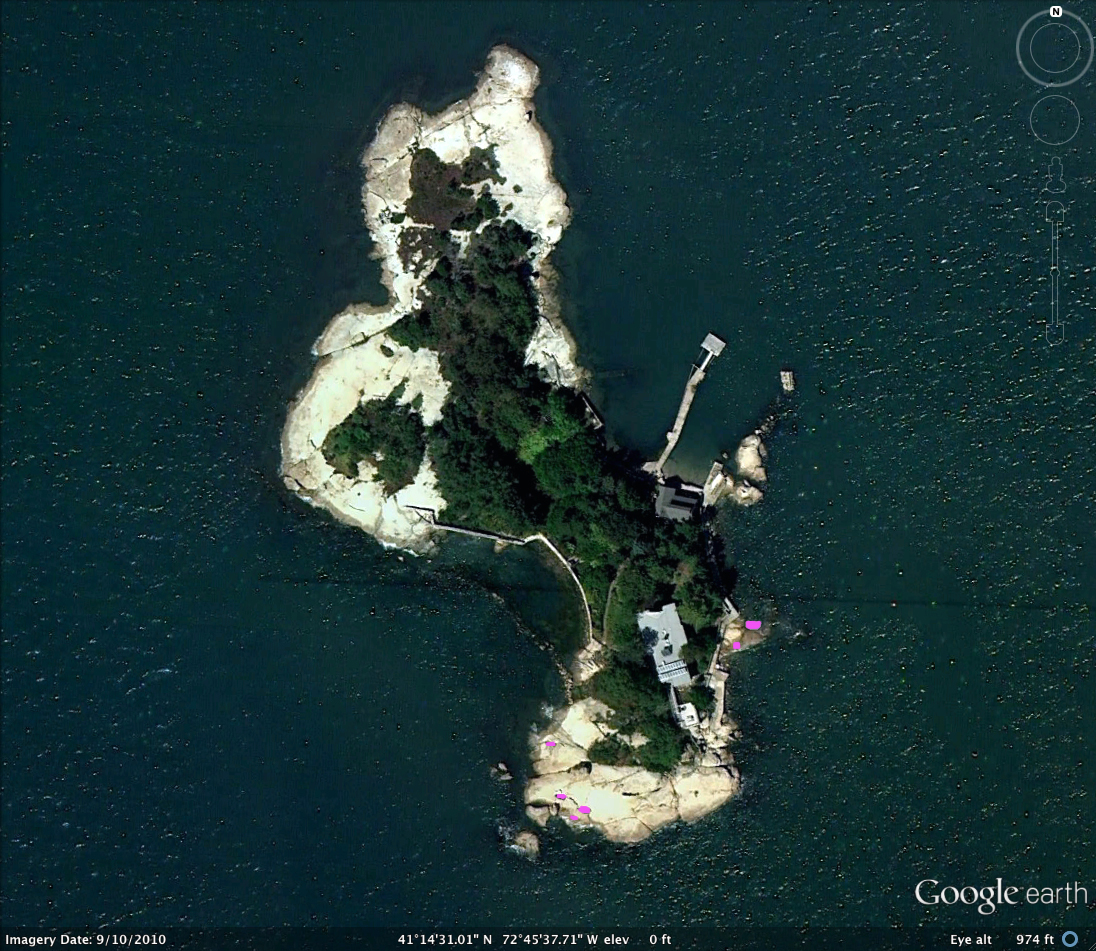Tide Pools

TIDE POOLS Tide Pools include wave-battered depressions in exposed bedrock. Tide Pools are common throughout New England, wherever bedrock outcrops at the shoreline or high energy waves remove the local glacial veneer.
PHYSICAL FEATURES Tide Pools offer algae and animals a hard substrate on which to attach. This means that organisms with some method of attaching to hard surfaces find a ready home on the rocks. Many species of algae and animals are well-adapted to the constant variation in submergence, temperature, oxygen and salinity they experience as members of a rocky shore Tide Pool community.
Habitats are similar to other intertidal - include the bare face of rocks, cracks and crevices, intertidal spaces between the algae and animals and tidepools. Micro-habitats on the hard rock surfaces are further modified by their exposure to the sun. Community composition may differ depending on amount of exposure to the sun. In addition to the communities living on the surface of rocks, where cobbles and boulders are the rule, different communities live under the rocks.
Tides The average tidal exchange at Outer Island is 9.5 feet (3 m). Extreme spring tides exceed 12 feet (4 m). The diurnal rise and fall of the tides means that each part of the intertidal zone is covered with water for different lengths of time.
In addition to the variable living conditions of this zone, high energy waves are often part of the physical characteristics of a rocky shore and tide pool environment. The waves challenge the animals' and algaes' ability to hang on while providing oxygen and nutrients.
ZONATION OF THE ROCKY SHORE The organisms of the rocky shore distribute themselves naturally according to their abilities to withstand desiccation and tolerate the variability of the habitat. This distribution of organisms results in wide horizontal bands, or zones, readily distinguished by the colors of the organisms living in them.
The Spray Zone The spray zone is also called the black, supratidal or supralittoral zone. Just beyond the reach of the highest high tide is a slippery, gray-black zone that receives moisture only from the splash of waves at the highest tides, during storms or from rainfall. Its dark color is due to black patches of the Cyanobacteria (Calothrix sp.), also known as blue-green algae, although it is a bacteria not an algae. When dry, these colonies resemble oil splotches stuck to the rocks. But when wet they are very slippery, as they become physiologically active. Periwinkles venture into the lower parts of the spray zone. In this zone, we also find a few barnacles that eke out a living in the spray that falls there.
The Intertidal Zone This encompasses the entire area between high, high water and low, low water lines, and contains several sub-zones: upper, middle and lower. The Upper Intertidal/Periwinkle Zone Also known as the periwinkle zone, the upper intertidal zone is located near the high tide line. This area is submerged regularly at high tide. The animals and algae that live here must be able to survive without water for ten to eleven hours at a stretch. Often the zone contains animals that can trap sea water and close out rain water while the tide is below them. Common species include: periwinkles, dog whelks, small blue mussels and a thin algal film. Where tidepools occur, there are often bright green colonies of Cladophora sp., a filimentous green alga and Enteromorpha sp., a tubular green alga. The green algae respond well to high levels of nitrogen and often signal waste pollution leaching into the intertidal region.
The Middle Intertidal/Barnacle-Rockweed Zone Also known as the barnacle or rockweed zone, this band comprises the greatest part of the intertidal zone. In the Boston area it is dominated by two genera of brown algae, common rockweed (Fucus sp.) and knotted wrack (Ascophylum nodosum), also often called rockweed. Fucus is a flattened drab green color with a midrib running down the thallus. It often has swellings that may function as floats or reproductive structures. Ascophylum also is drab green but lacks the midrib and has regular swellings that always act as 50 New England Aquarium floats. Common species aside from the dominant seaweeds include: common periwinkles (Littorina sp.), barnacles (Balanus sp.) blue mussels (Mytilus edulus), limpets (Acmaea sp.), slipper shells (Crepidula fornicata), sea stars (Asterias vulgaris) and a few worms living in mussel beds and seaweed turfs. Living on the algae we often find a tiny, coiled poly- chaete worm called Spirobis. When submerged, this worm has brightly-colored gills which project out into the water and disappear instantly when disturbed. Observe with a hand lens.
The Lower Intertidal Zone/Irish Moss Zone This area is just above the low tide mark. Here, the rockweeds are replaced by the red algae, Irish moss (Chondrus crispus). This area is exposed only at very low tides. Here we find well-developed beds of blue mussels and organisms that live in association with the mussels. Gently pry apart a few mussels and note the many worms and arthropods using the mussels for protection. Diversity here is greater than in the zones above. This is typical of a more stable and less stressed habitat. Low diversity and high density usually denote a highly-stressed environment.
The Subtidal Zone/Kelp Zone Except for the extreme spring tides of winter, this area is always underwater and is therefore much more stable than the rest of the rocky shore. The subtidal zone extends downward as far as sunlight can penetrate. This varies with the clarity of the water (turbidity). Large leathery kelps, soft filimentous red algae, red crustose algae, sea stars and sea urchins are commonly found here along with the typical fauna of New England nearshore waters.
SPECIAL ADAPTATIONS/WHAT TO LOOK FOR
Whether rocky shore inhabitants live in tidepools or on exposed rocks, they all have to contend with waves, air exposure, and fluctuating temperatures and salinity. Periwinkles have hard, pointed shells to minimize the impact of crashing waves. A periwinkle's foot can hold tightly to the rock surface. They glue themselves to the rock with a sticky substance that seals them off from the dry air. Barnacles glue themselves to the rocks and other barnacles with an extremely strong glue. They, too, can close the plates that cover their opening to hold water while they are high and dry. Sea stars and sea urchins use their tube feet for suction. Seaweeds have special structures called holdfasts by which they attach to the rocks. A mussel has a special gland on its foot that secretes a protein that sticks to the rocks and forms the byssal threads by which they remain attached to the rocks and tether themselves together.
NATURALIST NOTES
Among the many things to observe in the rocky intertidal zone are the algae that form the base of the food chain. The large seaweeds are conspicuous, however much less obvious are the splotches of red and pink on the rocks that represent encrusting red algae. Most of the gastropods (snails, limpets and chitons) graze on these films with a modified mouth structure called a radula. Look for grazing marks on the rocks. With a hand lens note the many smaller algae growing on the seaweeds. These are epiphytes and come from several phyla of algae. Along with algae, hydrazoans and bryozoans may live as epiphytes on the seaweeds. These are very beautiful when viewed with a 10x lens.
Slipper shells are frequently piled three and four deep on top of one another. Note that only the animal living in the bottom shell is female. All of the others are male. Should the female die, the first male changes sex to become a female (yes, slipper shells are hermaphroditic). Remove a pile of slippers from a rock and you may see clusters of eggs under the shell.
The above text is adapted from New England Aquarium's Boston Harbor Seaside Educator's Guide
(illustrations after Cindy Lydon - NEAQ Boston Harbor Seaside Educator's Guide)
